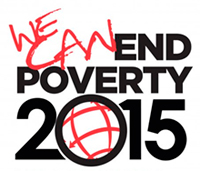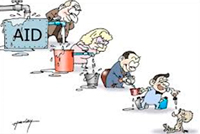International Development Cooperation
In
Log in if you are already registered
The meaning of expressions like foreign assistance/ aid or international development cooperation is very broad and not always clearly defined. In general they include different financial and technical transfers from rich to poor countries. These transfers are a rather new phenomenon in international relations that in its modern sense appeared only after the Second World War when the reconstruction of devastated Europe was strongly supported by the USA and since the decolonization period when former colonizers (claim to) assist the development of former colonies. Although there are many single success stories, so far development aid has failed to achieve its aims. Theoreticians and practitioners have found different explanations and fiercely debate.
 On the one hand, it is argued that the amount of international assistance is simply not enough in order to solve most of the development challenges in the developing world. Most NGOs and international organizations reason like this and therefore demand an increase of the money allocated to the poor. It is for this reason that since 1970 for example developed countries’ governments have promised innumerable times to increase their Official Development Assistance to 0,7% of their GNI. (1) They have programmes and strategies that aim to solve poverty problems in developing countries only with the help of development aid from developed countries, such as the Millennium Development Goals. The economist Jeffrey D. Sachs is currently one of most famous advocates of this opinion. His idea is simple and plausible: aid has supported development and improved the life of many people. Worldwide poverty, illiteracy, illness, death rates etc. have indeed strongly decreased during the last 50 years. But there are still many problems as the aid per person was very little, in the poorest continent Africa, for example only about 35$ per person per year since 1960 and thus not enough in order to break the vicious circle of poverty. Therefore a big push strategy is needed. (2)
On the one hand, it is argued that the amount of international assistance is simply not enough in order to solve most of the development challenges in the developing world. Most NGOs and international organizations reason like this and therefore demand an increase of the money allocated to the poor. It is for this reason that since 1970 for example developed countries’ governments have promised innumerable times to increase their Official Development Assistance to 0,7% of their GNI. (1) They have programmes and strategies that aim to solve poverty problems in developing countries only with the help of development aid from developed countries, such as the Millennium Development Goals. The economist Jeffrey D. Sachs is currently one of most famous advocates of this opinion. His idea is simple and plausible: aid has supported development and improved the life of many people. Worldwide poverty, illiteracy, illness, death rates etc. have indeed strongly decreased during the last 50 years. But there are still many problems as the aid per person was very little, in the poorest continent Africa, for example only about 35$ per person per year since 1960 and thus not enough in order to break the vicious circle of poverty. Therefore a big push strategy is needed. (2)
 On the other had there seems to be increasing number of opponents of the transfer of money, goods and services from rich to poor countries, especially in the poor countries themselves like for example Dambisa Moyo, James Shikwati, etc. The most radical ones say that not only foreign aid does not bring any benefit to the populations of the recipient countries but it even harms them as it undermines local industries, business and markets, as well as a reasonable, democratic, transparent political decision making; it supports dictators, bureaucracies, corruption and dependency. Poor countries become used to it and dependent on others like small children. As it is “free money” for the governments they are accountable neither to money lenders and nor to their population and do not have to face the consequences of their bad ruling. Food, clothes, technical equipment, and other products that are sent to developing countries weaken the local producers as they cannot sell in the same quantities and at the same prices as before. Often there are few or no trade links between neighbouring states as it is easier to receive goods from rich countries for free. Developing aid is thus a vicious circle itself that can only be broken if the aid is stopped completely. Usually the real solution is seen in more trade and foreign direct investments.(3)
On the other had there seems to be increasing number of opponents of the transfer of money, goods and services from rich to poor countries, especially in the poor countries themselves like for example Dambisa Moyo, James Shikwati, etc. The most radical ones say that not only foreign aid does not bring any benefit to the populations of the recipient countries but it even harms them as it undermines local industries, business and markets, as well as a reasonable, democratic, transparent political decision making; it supports dictators, bureaucracies, corruption and dependency. Poor countries become used to it and dependent on others like small children. As it is “free money” for the governments they are accountable neither to money lenders and nor to their population and do not have to face the consequences of their bad ruling. Food, clothes, technical equipment, and other products that are sent to developing countries weaken the local producers as they cannot sell in the same quantities and at the same prices as before. Often there are few or no trade links between neighbouring states as it is easier to receive goods from rich countries for free. Developing aid is thus a vicious circle itself that can only be broken if the aid is stopped completely. Usually the real solution is seen in more trade and foreign direct investments.(3)
 In between these two extreme positions, there are many more opinions that only partly criticize international aid. William Easterly for example who is famous for criticizing current development aid strategies argues that the problem is the paternalism of the donors, as they usually do not consider the opinion of the concerned people, i.e. the poor. (4) Others argue that NGOs provide targeted and efficient aid while Official Aid is politically influences and gets lost in bureaucracy and corruption. As there are different forms technical and financial, direct and indirect involving public and private, international and national, for-profit and non-profit actors there are many proponent of a certain type of development cooperation stating that the reason for the failure is not the idea aid itself but its realization.
In between these two extreme positions, there are many more opinions that only partly criticize international aid. William Easterly for example who is famous for criticizing current development aid strategies argues that the problem is the paternalism of the donors, as they usually do not consider the opinion of the concerned people, i.e. the poor. (4) Others argue that NGOs provide targeted and efficient aid while Official Aid is politically influences and gets lost in bureaucracy and corruption. As there are different forms technical and financial, direct and indirect involving public and private, international and national, for-profit and non-profit actors there are many proponent of a certain type of development cooperation stating that the reason for the failure is not the idea aid itself but its realization.
Empirically it is very difficult to prove the real influence of development as there are many interdependent indicators. Therefore the debate is shaped very much by contradicting facts and figures as well as moral accusations. So is more, less, another type of or simply no international aid needed? In the following posts I am going to analyze different opinions and on international development cooperation and development theories in general by looking more closely at specific issues, countries and projects. Why are some more successful that others? How has development cooperation changed over time? How are different other issues like economic growth, globalization, human rights, democracy etc. linked to development? What role do rising powers like for example Russia and China play? These are some of the questions I would like to discuss in this blog and I hope that you will join the discussion.
I am waiting for your comments, critiques, questions!
1. The 0.7% ODA/GNI target - a history. http://www.oecd.org/dac/stats/the07odagnitarget-ahistory.htm
2. Sachs, Jeffrey. Moyo's Confused Attack on Aid for Africa. http://www.huffingtonpost.com/jeffrey-sachs/moyos-confused-attack-on_b_208222.html
3. For example: - Moyo, Dambiasa. Dead Aid: Why Aid Is Not Working and How There Is a Better Way for Africa. - Shikwati, James. http://www.spiegel.de/international/spiegel/spiegel-interview-with-african-economics-expert-for-god-s-sake-please-stop-the-aid-a-363663.html
4. Easterly, William. The White Man's Burden




